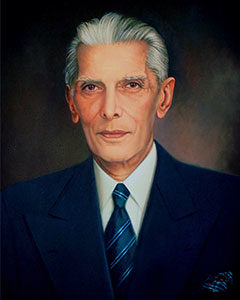
Contributed by Mr. Tariq Noor, Ontario Canada
Jinnah dressed himself perfectly, his elegant and magnificent personality gave him respect wherever he went. It is narrated that on visit to London for political meeting he stayed in hotel. In the morning, he descended from his hotel suite into the breakfast hall, using stairs. When the people present in the restaurant noticed him they all rose involuntary and stood up as a gesture of respect to him.
Jinnah was one of the New York Times best dressed men of 1946. Expressing his thoughts on Muhammad Ali Jinnah, Lord Wavell (Viceroy of India, 1943-1947) said, “Mr. Jinnah was one of the handsomest men I have ever seen; he combined the clear cut, almost Grecian features of the West with oriental grace and movement.”
A research states that one of the main reasons why Muhammad Ali Jinnah is considered one of the most well-dressed men in history has to do with the fact that he was a huge supporter and wearer of the well-tailored suit. Never one to sit back and wear whatever came through the door. It is said that before independence, Jinnah came to own over 200 suits, which he wore with heavily starched shirts with detachable collars.

Jinnah’s outfits were always unique; he rarely appeared wearing the same thing more than once. In a time when poverty ran rampant, Jinnah was one of the few who was able to partake in the wondrous ways of fashion. Congratulations to Muhammad Ali Jinnah for being voted the Fifth Best-Dressed World Leader of all-time.
After meeting Jinnah at the Viceroy’s dinner in Simla, a British general’s wife wrote to her mother in England: “After dinner, I had Mr. Jinnah to talk to. He has a great personality. He talks the most beautiful English. He models his clothes and his manners on Du Maurier…, and his English on Burke’s speeches. I have always wanted to meet him and now I had my wish.”
His monocle, his double-breasted jackets, and his Craven “A” cigarettes gave his personality a unique style. He was fond of smoking expansive and finest ‘Craven A cigarettes. He also smoked a special kind of ‘Havana’ cigars, and sometimes a pipe.
When Allama Inayatullah Khan Mashriqi, the founder of the Khaksar Movement, was released from a U.P. jail, the Quaid-i-Azam, on the advice of some of his friends, went to see him along with his colleagues. He was accompanied by Liaquat Ali Khan, Sir Abdullah Haroon and Pir Ali Mohammad Rashidi. In Qarul Bagh, Allama Mashriqi was staying in a huge tent in the middle of the Khaksar Camp. An ordinary dari had been spread on the floor inside the camp. There was no chair.

The Quaid-i-Azam was wearing a white suit of China silk. He was not in the habit of sitting on the ground. However, as there was no alternative, he sat down on the floor after shaking hands with Allama Mashriqi. The Quaid then took out his cigarette case and offered a cigarette to him. Allama took the cigarette and tried to give two paisas to the Quaid. The Quaid-i-Azam asked: What is this? Allama said: A Khaksar does not accept any thing without paying its price. On hearing this, the Quaid took back his cigarette from Allama and said: The price of my cigarette is much more than two paisas and I don’t think you can afford it.
His monocle was a part of his majestic personality. In a court of law while making arguments, monocle, which Jinnah was using, for reading from his notes slipped from his eye and dropped on the floor. The magistrate mischievously grinned and felt delighted, anticipating that Jinnah would have to bend in his court to pick up the monocle. He was disappointed when Jinnah put his hand in his pocket, brought out another monocle, and applied it to his eye while continuing the arguments.
By the late 1930s, He was mostly seen wearing a ‘Karakul’ hat, also known as ‘Jinnah Cap,’ over his western clothing. The moment he became a leader of a Muslim country, he chose to wear a sherwani. He stopped wearing the UP and Delhi style chooridar or tight pyjamas, and preferred a loose fitting ‘Shalwar’ the Jinnah cap and white or cream colored sherwani become the trend of that time. Meanwhile, he wore suits for his day-to-day office work and on informal occasions.
The Quaid’s magnificent personality traits left deep impact to everyone. Patrick Spens, the last Chief Justice of undivided India, paid the following tribute to Jinnah: “The tallness of the man, the immaculate manner in which he turned out, the beauty of his features and the extreme courtesy with which he treated all; no one could have made a more favorable impression than he did. There is no man or woman living who imputes anything against his honor or his honesty. He was the most outright person that I know.”
The Quaid usually travelled by train during the pre-independence time. Journalist once confronted Jinnah with a question as to how Congress leadership travelled in third class like the working class while he enjoys the first class journey. Quaid’s reply was sharp. He said that he travelled in first class but pays from his own pocket to buy the ticket, while the congress leaders travel in third class without ticket. It made headlines. Dear father of the nation you will be in our memories forever.


